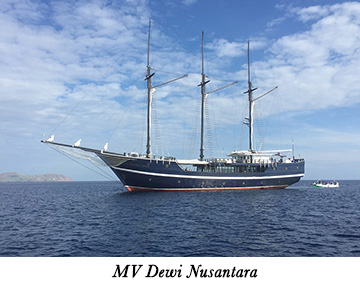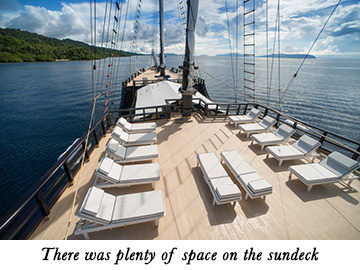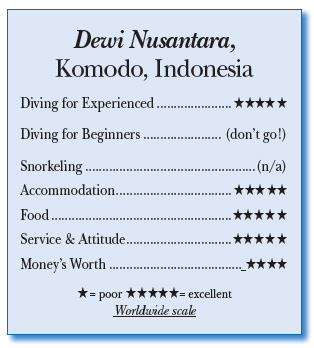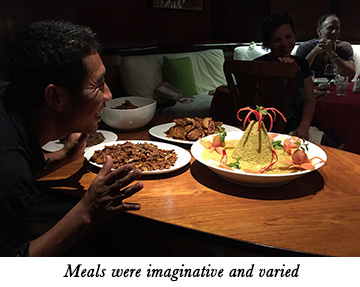Dewi Nusantara, Komodo, IndonesiaContents of this Issue: Dewi Nusantara, Komodo, Indonesia Sick Divers, Macho Divemasters Flying After Diving, Researchers Need Your Help G’day Mate, Do You Want A Lift? Underwater Statues and Sculpture Parks When Your Liveaboard Doesn’t Go Where It Promised Stop Using Aqua Lung Powerline Inflators Immediately! Equipment Issues from our Readers When Great White Cage Dives Go Awry An American Immersion: The First Woman To Dive All 50 States Editorial Office: Ben Davison Publisher and Editor Undercurrent 3020 Bridgeway, Suite 102 Sausalito, CA 94965 luxurious living, remarkable diving from the November, 2016 issue of Undercurrent
Dear Fellow Diver, Andrea, the friendly English Dive/Cruise Director from Southhampton, in her low-key way, introduced us 11 divers to all the details of the beautiful Dewi (pronounced day-wee) Nusantara, as well as the planned itinerary and the dive procedures. But, there came a clinker. Since we were lucky to have two marine biologists on board, one the veteran Mark Erdmann, she said they would modify the advertised Komodo itinerary and take two days to explore a few unknown areas, primarily muck dives. "After all, you don't want to spend your whole trip just diving Komodo." What? I booked my July trip for very good money to dive Komodo, and now that I'm onboard they're changing the itinerary. I'm no muck diver. I held my tongue.
We left dock around dinner time, with plans to travel seven hours to our first exploratory dive site. "Seas might be wavy," Andrea advised, but the ride was smooth (as rides were throughout the trip) and I slept well in the perfectly air conditioned cabin, only to awake in the morning to another hitch. An engine had lost an oil line during passage, so we had stopped cruising and would dive unplanned locations near Gili Trawangan to wait for the hose to be boated to us. Andrea explained that the sites had been dynamite-fished so that we would be muck diving amid rocks and rubble. Afterward, most divers (other than the two marine biologists) and I were disappointed in the dives, though a few night divers enjoyed their findings. Yet, throughout the day, each of the upbeat 23-member crew handled the situation with aplomb, and at dinner we heard the good news: they had fixed the engine, and it would be 16 hours at full speed to catch up to our itinerary. The next morning, we arrived at Sumbawa Teluk Saleh/Tansung Bara for exploratory muck dives. My wife and I, along with our helpful, excellent critter finder dive guide, Andre -- a powerfully built Indonesian with a huge smile -- let the current slowly carry us over a hundred yards of a sparse coral reef swarming with fish. It felt unique and wild to be somewhere virtually unexplored. In 81-degree (27°C) water and 40-foot (12m) visibility, I encountered a mimic octopus, nudibranchs, and a bunch of other critters in the dark brown volcanic sand, called "black sand." Commensal shrimp, mushroom coral pipefish, various morays and black garden eels were among the discoveries. More than once, Erdmann, the highly regarded marine biologist, commented, "I think I found a new species! And after another dive, he exclaimed, "What you saw is really rare! I could dive here all week!" To collect specimens, Erdman would squirt a clove oil anesthetic into the holes, then bring the specimens back to the boat, pin them to the bottom of his shower shoe, then measure and catalog them. Andre was our dive guide the whole trip (two divers to one guide is the rule), which allowed a great relationship to develop as Andre learned exactly what we wanted to see. We made two more muck dives -- 20-foot (6m) viz -- and no night dive, since we were still behind our schedule. The two tenders were cranked up by crane for storage on the aft of the ship, and off we went.
At dinner, Andrea mentioned that we'd had a "successful day of diving," and I suppose the marine biologists did, but several of my fellow divers and I were concerned. I was eager to visit the sites that I'd read so much about and paid dearly to dive. Earlier, Andrea had said "Ask if you have any concerns so that we can address them. It's too late for us to fix things at the end." So, I asked if we could check the plan, and Andrea reassured us that beautiful coral reefs were coming, and, yes, some muck dives would be part of the trip. Repairing to my cabin, #3 on the starboard side (there are eight twin staterooms and one master suite), was always a pleasure. The curved dark wood hull was one of our walls, with a porthole for fresh air. We had plenty of cabinet space and storage. Small LED lights calmly lit the room, and when one flickered, a crew member replaced it within minutes. The well-designed wooden bathroom sported a glass bowl sink; the spacious shower, with a stone tile wall and floor, produced plenty of hot water. The comfortable double-wide bed provided room to climb out either side.
Day Three delivered! At Sangeang Main Island, Tikno Reef started as a sloping expanse of awesome colorful coral gardens filled with millions of reef fish. Breathtaking! At Hot Rocks, volcanic bubbles streamed from the sand. Lighthouse Reef was more of a muck-dive-critter-finding thing -- warty frogfish, decorator crabs, plenty of nudis. Currents were all over the place: this way, that way, down, up . . . but no one was in danger, because every diver had good diving skills, and the guides kept a close watch. That said, this is no trip for beginners without precise buoyancy skills and current comfort. Since water temperature swung between 75 and 86 degrees (24- 30°C), wearing the right thermal protection was tricky. In fact, I wasn't well prepared, leading to serious shivers on some colder dives. I asked Andrea if she had rubber I could add and she had me covered for the next dive. When I needed batteries for my dinosaur night dive lights, she came up with rechargeable AAs. After stabbing my finger with my dive knife while modifying my veteran vest, she had first-aid in moments. When I needed a tie line to fix my vest, Yan rousted some up right away. Yan, by the way, was the private dive guide for a friendly but shy Japanese woman who dived with Dewi often, to focus on photographing tunicates; one of her published photo books was on the boat.
At the park, we hiked around to see several amazing Komodo dragons, as well as plenty of monkeys. Taking a tender trip to one uninhabited island, we spotted three scrawny hungry dragons coming down to meet us. (Per the plan, we stayed on the boat!) We also hiked to the 'pink sand' beach, where billions of grains of broken coral give the sand a unique tone, and we hiked to a pinnacle lookout for sunset that was stunning, overlooking a cut between islands with two separate bays and sand shallows, dotted with interesting 'backpacker level' dive boats. While no one ever got lost diving, the Dewi website stated that divers would not be allowed to dive unless they carried a Dive Alert air horn and a rescue strobe. I noticed this just a few days before departure (the pretrip paperwork didn't mention it), so I rushed to order two sets online and have then FedExed, only to find out from Dewi during an airport layover that they were NOT required. During the first dive briefing, Andrea mentioned that they want all divers to have an audio signal, which could be a whistle and a large safety sausage. Good ideas, both, but the paperwork should better address these requirements. (The website still has erroneous information.) South of the park diving, in mostly 75-degree (24°C) water with 20-foot (6m) viz, looked like a snowstorm, but the reefs were healthy, and there was massive biodiversity for critter hunting -- a 10X magnifying lens helped. But north, the water was 81-82 degrees (28°C), with much better viz, and fantastic coral gardens sported massive schools of fish. One dive had so many anthias (and other fishes in the blend) that I almost couldn't see through them for the entire dive! Some dives were overwhelming, and virtually everyone was a grand ole time, as we ogled cuttlefish, hawksbill turtles, and reef fish such as big bumphead parrots and colorful butterflies. In Manta Alley, about 20 mantas schooled in front of us the entire two dives, filter feeding high in the morning, and getting cleaned deeper in the day.
Our final two dives were classic 'muck' dives in the trash-sand of Bima Bay. While I was skeptical about muck diving when I started this trip -- I'm more of a big environment, fish aficionado -- these dives made me a convert as I floated through the calm water hunting for mysterious creatures. On the disembarking day, tenders took us to the dock to meet our drivers. At the airport, porters took the group's luggage through security to the check-in. There was some mix-up, however, when the I was confronted later in the waiting room by an airport official with a porter tagging along, demanding tips for carrying the entire group's bags, even though I wasn't in charge of the group. We had presumed Dewi had taken care of tips, but truth is they hadn't. Clear this up with Dewi before reaching the airport. I returned home with a huge Go Pro library of different animals and critters and corals and fishes and dragons and monkeys and sunsets and islands and . . . so many memories that will take a long time to absorb. The biodiversity was stunning, and combined with the Dewi Nusantara luxury service experience, this trip was, without a doubt, one that I will treasure forever. -- P.L. Our undercover diver's biog: "After four years of guarding U.S. embassies in the Marine Corps, I got YMCAcertified in 1979 wearing the old yoke vests and a giant dive knife on my calf for manliness. George, our instructor, would catch us by surprise by turning off our valves underwater and making us swim with our masks blacked out by tinfoil. I've logged 747 recreational dives (DM certified) all over the world, and I've made enough stupid safety mistakes to ensure that George would wonder if I paid attention to his training."
|

I want to get all the stories! Tell me how I can become an Undercurrent Online Member and get online access to all the articles of Undercurrent as well as thousands of first hand reports on dive operations world-wide
| Home | Online Members Area | My Account |
Login
|
Join
|
| Travel Index |
Dive Resort & Liveaboard Reviews
|
Featured Reports
|
Recent
Issues
|
Back Issues
|
|
Dive Gear
Index
|
Health/Safety Index
|
Environment & Misc.
Index
|
Seasonal Planner
|
Blogs
|
Free Articles
|
Book Picks
|
News
|
|
Special Offers
|
RSS
|
FAQ
|
About Us
|
Contact Us
|
Links
|
3020 Bridgeway, Ste 102, Sausalito, Ca 94965
All rights reserved.

 My partner and I were already a little anxious,
thanks to an earlier hitch in getting picked up at our
hotel for transport to the boat. With no driver 35 minutes
after scheduled pickup time, I called the phone
numbers Dewi had provided, but no answer. Was there a glitch in logistics?
Would I become the
guy who misses his
dive boat and has
to figure out how
to hook up with it
somewhere in the
middle of the ocean?
Then I remembered an
email address that
Mike Hoppe, our fine
Reef and Rainforest
travel consultant,
had printed on our
voucher. Boom ...
instant response. No worries, the driver was just stuck
in traffic. After picking us up, he
honked his way through the scooterchaos
of Bali traffic. At the harbor,
we boarded a tender for the 191-foot
topsail schooner Dewi Nusantara, boarding her from the outboard staircase.
Welcome, welcome ... we were
greeted warmly.
My partner and I were already a little anxious,
thanks to an earlier hitch in getting picked up at our
hotel for transport to the boat. With no driver 35 minutes
after scheduled pickup time, I called the phone
numbers Dewi had provided, but no answer. Was there a glitch in logistics?
Would I become the
guy who misses his
dive boat and has
to figure out how
to hook up with it
somewhere in the
middle of the ocean?
Then I remembered an
email address that
Mike Hoppe, our fine
Reef and Rainforest
travel consultant,
had printed on our
voucher. Boom ...
instant response. No worries, the driver was just stuck
in traffic. After picking us up, he
honked his way through the scooterchaos
of Bali traffic. At the harbor,
we boarded a tender for the 191-foot
topsail schooner Dewi Nusantara, boarding her from the outboard staircase.
Welcome, welcome ... we were
greeted warmly.  The huge covered dive deck had plenty of room to store and hang gear, soak
cameras and suits, as well as two dining tables that each seated 10 guests. After
each dive, when the tenders arrived back at the mother ship, the staff greeted us
with cheers and high fives on the boarding staircase (I wondered -- was it because
we made it back alive?) Yeah, it's corny, but I smiled every time. I'd rinse
off at one of two warm freshwater deck showers (there are two heads off the dive
deck), then, after being handed a fresh towel, I'd sit in a chair for a short back
and neck massage . . . after every dive!
The huge covered dive deck had plenty of room to store and hang gear, soak
cameras and suits, as well as two dining tables that each seated 10 guests. After
each dive, when the tenders arrived back at the mother ship, the staff greeted us
with cheers and high fives on the boarding staircase (I wondered -- was it because
we made it back alive?) Yeah, it's corny, but I smiled every time. I'd rinse
off at one of two warm freshwater deck showers (there are two heads off the dive
deck), then, after being handed a fresh towel, I'd sit in a chair for a short back
and neck massage . . . after every dive! Mornings began with a light breakfast before the first dive (07:15-08:00),
followed by eggs Benedict, eggs Florentine, omelets, bacon, pancakes, French
toast, or an Indonesian breakfast -- a bowl of buckwheat noodles and veggies,
topped off with a fried egg . . . and lattes or cappuccinos . . . Another dive,
then a buffet lunch, perhaps fried shrimp or curried chicken, with a delicious
salad and wok vegetables. Then an afternoon dive followed by snacks such as egg
rolls or fried bananas with caramel and cinnamon. A predinner night dive was followed
by hot chocolate upon arrival at the boat, and a gourmet individually plated
dinner. Fresh cream of mushroom, asparagus, brocolli, lentil soups, delicious
garlic toasted baguettes, a salad, then an Indonesian dish, and seared tuna, beef
saltimbocca, roasted chicken, rack of lamb, snapper, a tough sirloin, vegetarian
options. Delicious! To ensure one was satisfied, Jun, the maître d, was around
from wake-up to bedtime, with a smile asking "Would you like something to drink.
I get you something?"
Mornings began with a light breakfast before the first dive (07:15-08:00),
followed by eggs Benedict, eggs Florentine, omelets, bacon, pancakes, French
toast, or an Indonesian breakfast -- a bowl of buckwheat noodles and veggies,
topped off with a fried egg . . . and lattes or cappuccinos . . . Another dive,
then a buffet lunch, perhaps fried shrimp or curried chicken, with a delicious
salad and wok vegetables. Then an afternoon dive followed by snacks such as egg
rolls or fried bananas with caramel and cinnamon. A predinner night dive was followed
by hot chocolate upon arrival at the boat, and a gourmet individually plated
dinner. Fresh cream of mushroom, asparagus, brocolli, lentil soups, delicious
garlic toasted baguettes, a salad, then an Indonesian dish, and seared tuna, beef
saltimbocca, roasted chicken, rack of lamb, snapper, a tough sirloin, vegetarian
options. Delicious! To ensure one was satisfied, Jun, the maître d, was around
from wake-up to bedtime, with a smile asking "Would you like something to drink.
I get you something?" At Padar Island Secret Garden in Komodo National Park, the water was 75
degrees (24°C) with 20-foot (6m) viz. My bright flashlight beam found tiny creatures
hidden in the shaded coral crevices, as well as bringing out the color. Of
course, there was plenty to see, giant frogfish, mobula rays, glass fish and batfish
among the discoveries.
At Padar Island Secret Garden in Komodo National Park, the water was 75
degrees (24°C) with 20-foot (6m) viz. My bright flashlight beam found tiny creatures
hidden in the shaded coral crevices, as well as bringing out the color. Of
course, there was plenty to see, giant frogfish, mobula rays, glass fish and batfish
among the discoveries. On almost all dives, the topography was a form of a sloping reef, with the
varying pitch, and some had level coral gardens. A few dives were on walls, but
never big canyons or swim-thrus. During every dive, we had our safety stop in a
coral garden, except just one where we drifted in open water. Upon surfacing, the
tender would come right up, I'd pass up my gear, fins included, and climb the
solid side ladder. Andre was always right here, in case I needed a hand.
On almost all dives, the topography was a form of a sloping reef, with the
varying pitch, and some had level coral gardens. A few dives were on walls, but
never big canyons or swim-thrus. During every dive, we had our safety stop in a
coral garden, except just one where we drifted in open water. Upon surfacing, the
tender would come right up, I'd pass up my gear, fins included, and climb the
solid side ladder. Andre was always right here, in case I needed a hand. Divers Compass: The 12-day, 11-night trip was $5995/person . . . Of
course, Nitrox 32 was the gas de riguer . . . . They sell muck
sticks, which are valuable to poke for critters and useful to keep
you from accidentally bumping the reef when the underwater wind
whips you around . . . .They offer a complimentary glass of wine
with dinner. You can buy wine or hard liquor; free beer and soft
drinks are available all day, as are coffee, tea and cookies. . . .
As for tipping, five percent was considered low end, ten percent
high.
Divers Compass: The 12-day, 11-night trip was $5995/person . . . Of
course, Nitrox 32 was the gas de riguer . . . . They sell muck
sticks, which are valuable to poke for critters and useful to keep
you from accidentally bumping the reef when the underwater wind
whips you around . . . .They offer a complimentary glass of wine
with dinner. You can buy wine or hard liquor; free beer and soft
drinks are available all day, as are coffee, tea and cookies. . . .
As for tipping, five percent was considered low end, ten percent
high. 